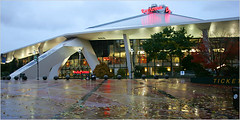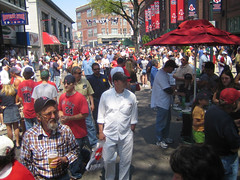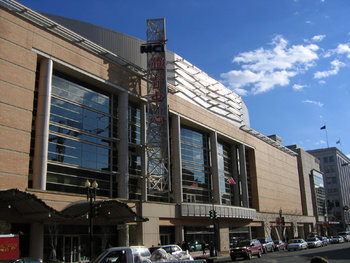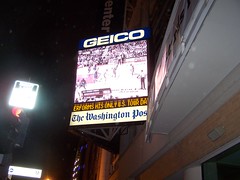More about the Seattle Supersonics and thinking about sports team subsidies
 Kevin P. Casey for The New York Times. KeyArena, home of the Seattle SuperSonics, was renovated in 1995 with $75 million from taxpayers. A vote last week against public subsidies for sports teams means the team will probably leave in 2010.
Kevin P. Casey for The New York Times. KeyArena, home of the Seattle SuperSonics, was renovated in 1995 with $75 million from taxpayers. A vote last week against public subsidies for sports teams means the team will probably leave in 2010.Hmm, despite Microsoft and Boeing's boom based on the troubles of the A380, all is not well in Seattle. The monorail requires millions of dollars in fixing, the plan to extend the monorail died, there is not a meeting of the minds on whether to remove an elevated freeway. And there were two very interesting results on local initiatives last week, one restricting strip clubs (defeated--strip clubs remain unfettered, see "4-foot rule's defeat means Seattle reverts to old law"), the other, Initiative 91, banned public funds to support sports teams.
I love the name of the group sponsoring the referendum, Committee for More Important Things. And I like the restriction on giving rich people subsidies.
Suzanne brings our attention to this article from the New York Times, "As Sonics Pack to Leave Town, Seattle Shrugs," and writes:
This was a quality district that was enhanced by the Key Arena - it was part of Queen Anne Hill and very close to the Space Needle (Seattle Center). Many events crossed over into both venues, as did many festivals, restaurants, bars, boutiques, coffee shops, etc. In fact in the scheme of things the Key Arena is not that old, so this is going to be a big shock to that community, especially since Seattlites are big Sonics fans (well they used to be when the Sonics did suck so bad...).
Before the Key Arena was around, the area as far as I know was pretty sketchy, so perhaps, depending on if they obliterate the Key Arena, it may reverate to its bad ways. Wouldn't know about the finance side about all of this but I can definitely see what kind of impact this will have on the urban/residential community that is right there... currently the top heavy sporting part of Seattle is farther South on HWY. 99 at the Safeco field which has turned a once dilapidated section into cheese/sporto central. That area used to be REALLY nasty. I'm speaking from experience.
I wrote back first:
You raise an interesting point. About "reproducing" otherwise negative spaces.
I do think there is a difference with arenas vs. stadiums. The former get used a lot more (basketball, hockey, concerts and other events) than stadiums, providing more support for business and other stuff around the arena. They are also much smaller. That means that they can be better integrated into urban fabric. A football stadium doesn't even get used 30 days/year. Baseball stadiums not much more than 81, a few more games if they make the playoffs. A few concert dates, but not many, because most concerts fit into arenas, not economically or comfortably in larger spaces. (Excepting U2, Rolling Stones, etc.)
And then more later:
You'd have to do a close figuring of the "value" and economic return of sports teams. Most reputable economists studying the issue find that it's merely a substitution effect, that people spend the same amount of money, just on different forms of entertainment.
However, I have come to accept that a sports team can increase "sampling" of the city by suburbanites, if the arena is well located and there are other attractions of quality nearby.
This is part of the argument that "MCI Center saved downtown," I argue that it contributed but (1) more importantly so did a relatively small inventory of developable commercial land and (2) that you need to ensure that there is a quality "district" around the site in order to extract more social and economic value for the city versus all the value being captured by the sports team/arena.
The sports teams at Verizon Center work to maximize value capture by scheduling events at a time making it inconvenient for people to go out to eat before, and having to work the next day means that except for events on the weekend, there is only a modicum of post-game hospitality business.
It helps that Verizon Center is used in the summer by the Mystics, and that winter usage is augmented by its role as the home arena for the Georgetown Hoyas basketball team. This means a lot more use, along with basketball, hockey, and concerts, compared to a football stadium for sure (most people tailgate, not spending much money locally) and even for baseball (although I have admitted that the Washington Nationals have had a positive and measurable financial impact on 8th Street SE).
 I would argue that Yawkey Way is a much more effective "money absorber" than the walk to Camden Yards in Baltimore. It's real, there's an extant district there. Camden Yards is located off to the side of downtown. Flickr photo by Shawn Morrison.
I would argue that Yawkey Way is a much more effective "money absorber" than the walk to Camden Yards in Baltimore. It's real, there's an extant district there. Camden Yards is located off to the side of downtown. Flickr photo by Shawn Morrison. Because of the failure to demonstrate substantive economic return, most sports teams argue about the social value to a city, rather than the economic value. That demonstrates they're losing the economic argument... Especially if you were to do a careful financial analysis, most of the money ends up in the pockets of the leagues, the team owners, and the players, with only a relative handful of residents deriving some wage benefits.
However, what money you can get changes greatly if there is a quality district around, like Wrigleyville in Chicago or the area around Fenway Park in Boston, or even the at the heart of the city Madison Square Garden in Manhattan--and maybe the Verizon Center...
 Verizon Center in MCI days.
Verizon Center in MCI days.In short, to make these kinds of "investments" successful:
1. The building must be integrated into the urban fabric. (I won't say sensitively because Verizon Center isn't.)
2. Well linked to transit, which most of the visitors use, rather than having to provide parking.
3. In an extant defined and exciting district (I have to admit, as a pro-urban person, that it's great to see scads of people walking up and down 7th Street NW, not just because of the arena, but it does contribute).
4. With many events scheduled, so that the building truly is a destination for much of the year.

But while I don't mind the video screen, the loudspeakers are TOO MUCH and usually set WAY TOO LOUD. (I wrote LOUT at first, and in effect, the Arena Management are louts for subjecting innocent passersby to ear splitting volumes.)
Also see these articles from the Seattle Times:
-- Why Seattle is losing the Sonics and Storm in 10 easy steps
-- Sponsors of I-91 tell others to heed vote
-- Horsefeathers: the legacy of I-91
-- Sonics' future points toward suburbs
Index Keywords: stadiums-arenas; urban-design-placemaking



0 Comments:
Post a Comment
<< Home